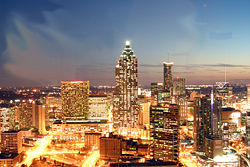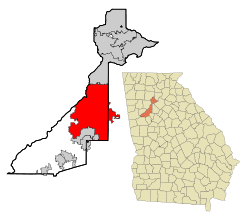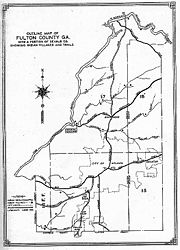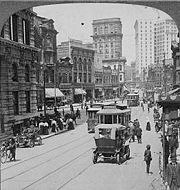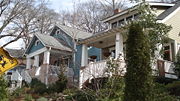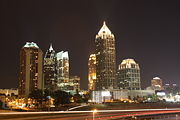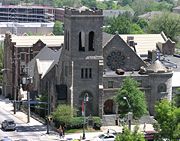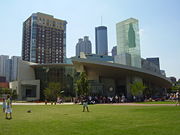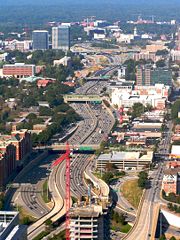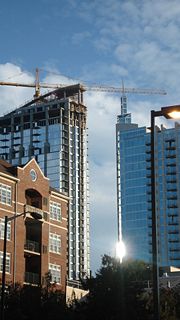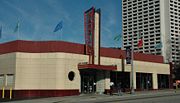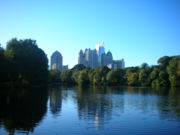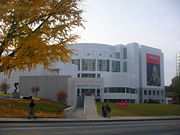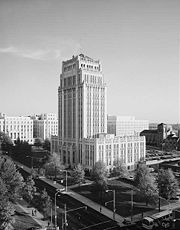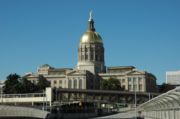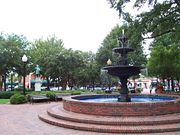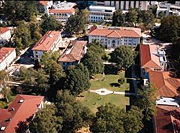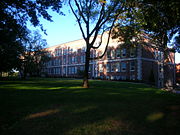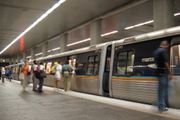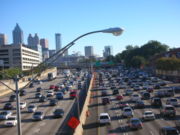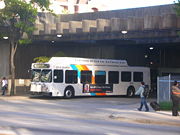Atlanta, Georgia
2008/9 Schools Wikipedia Selection. Related subjects: Cities; North America
| City of Atlanta | |||
| Downtown Atlanta seen from Bank of America Plaza. | |||
|
|||
| Location in Fulton and DeKalb counties and the state of Georgia | |||
| Coordinates: | |||
|---|---|---|---|
| Country | United States | ||
| State | Georgia | ||
| Counties | Fulton, DeKalb | ||
| Terminus | 1837 | ||
| Marthasville | 1843 | ||
| City of Atlanta | 1847 | ||
| Government | |||
| - Mayor | Shirley Franklin ( D) | ||
| Area | |||
| - City | 132.4 sq mi (343.0 km²) | ||
| - Land | 131.8 sq mi (341.2 km²) | ||
| - Water | 0.7 sq mi (1.8 km²) | ||
| - Urban | 1,962.9 sq mi (5,083.9 km²) | ||
| - Metro | 8,376 sq mi (21,693.7 km²) | ||
| Elevation | 738-1,050 ft (225-320 m) | ||
| Population (2007) | |||
| - City | 486,411 | ||
| - Density | 3,690.5/sq mi (1,220.5/km²) | ||
| - Urban | 3,499,840 | ||
| - Metro | 5,138,233 ( 9th Largest) | ||
| Time zone | EST ( UTC-5) | ||
| - Summer ( DST) | EDT ( UTC-4) | ||
| Area code(s) | 404, 678, 770 | ||
| FIPS code | 13-04000 | ||
| GNIS feature ID | 0351615 |
||
| Major Airport | Hartsfield-Jackson Atlanta International Airport- ATL (Major/International) | ||
| Website: atlantaga.gov | |||
Atlanta (pronounced /ətˈlæntə/) is the capital and the most populous city in the state of Georgia, as well as the core city of the ninth most populous metropolitan area in the United States with 5,138,223 residents. It is the county seat of Fulton County, although a small portion of the city extends into DeKalb County. Despite its large metropolitan area, as of July 2006, the city of Atlanta had a population of 486,411 making it the 34th largest city in the United States, and sixth largest city in the southeastern region behind Jacksonville, Memphis, Charlotte, Louisville, and Nashville. Residents of the city are known as Atlantans.
Atlanta has in recent years undergone a transition from a city of regional commerce to a city of international influence. Between 2000 and 2006, the metropolitan area grew by 20.5%, making it the fastest growing metropolitan area in the nation. Atlanta is sometimes considered a poster child for cities worldwide experiencing rapid growth and urban sprawl, though the city has recently been commended by bodies such as the Environmental Protection Agency for its eco-friendly policies.
History
On December 21, 1836 the Georgia General Assembly voted to build the Western and Atlantic Railroad to provide a trade route to the Midwest. Following the forced removal of the Cherokee Nation between 1838 and 1839 the newly depopulated area was opened for the construction of a railroad. The area around the eastern terminus to the line began to develop first. By 1842, the settlement had six buildings and 30 residents and the town was renamed "Marthasville". After a few renames, the Chief Engineer of the Georgia Railroad, J. Edgar Thomson, suggested that the area be renamed "Atlantica-Pacifica", which was quickly shortened to "Atlanta". The residents approved, and the town was incorporated as "Atlanta" on December 29, 1847.
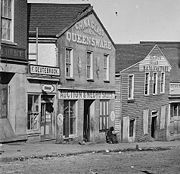
As more railroads were constructed, the town experienced a small boom, reaching 2,500 in population. In 1848, the first mayor was elected, the first homicide occurred and the first jail was built. Sidewalks were constructed and a town marshal appointed. By 1854 another railroad connected Atlanta to LaGrange, and the town grew to 7,741 by 1860.
During the American Civil War, Atlanta served as an important railroad and military supply hub. In 1864, the city became the target of a major Union invasion. The area now covered by Atlanta was the scene of several battles, including the Battle of Peachtree Creek, the Battle of Atlanta, and the Battle of Ezra Church. On September 1, 1864, Confederate General John Bell Hood evacuated Atlanta after a four-month siege mounted by Union General William T. Sherman and ordered all public buildings and possible Confederate assets destroyed. The next day, Mayor James Calhoun surrendered the city, and on September 7 Sherman ordered the civilian population to evacuate. He then ordered Atlanta burned to the ground on November 11 in preparation for his march south, though spared the city's churches and hospitals.
The rebuilding of the city — immortalized by the phoenix and motto "Resurgens" (Latin for "rising again") on the city seal — was gradual. From 1867 until 1888, U.S. Army soldiers occupied McPherson Barracks in southwest Atlanta to ensure Reconstruction era reforms. To help the newly freed slaves, the Federal Government's Bureau of Refugees, Freedmen and Abandoned Land [Freedmen's Bureau] worked in tandem with a number of freedmen's aid organizations, especially the American Missionary Association (A.M.A.). The A.M.A. established two well-respected black schools by 1866 (Storrs School and Summer Hill School) which became part of the Atlanta public schools in 1872. It also created the Washburn Orphanage to aid homeless children and launched the charter for Atlanta University in 1867, the first of several historically black colleges in Atlanta, in part to begin the training of black teachers. The First Congregational Church of Atlanta was begun as a collaboration between whites, especially Northerners of the A.M.A. and Atlanta's freedmen; today its congregation still celebrates their Reconstruction-era roots.
In 1868, Atlanta became the fifth city to serve as the state capital. Henry W. Grady, the editor of the Atlanta Constitution, promoted the city to investors as a city of the "New South", one built on a modern economy, less reliant on agriculture. In the 1880s Georgia School of Technology and Atlanta Hospital were founded.
As Atlanta grew, ethnic and racial tensions mounted. The Atlanta Race Riot of 1906 left at least 27 dead and over seventy injured. In 1913, Leo Frank, a Jewish supervisor at a factory in Atlanta was put on trial for raping and murdering a thirteen-year old white employee from a suburb of Atlanta, ultimately resulting in Frank's lynching.
With the entry of the United States into World War II, soldiers from around the Southeastern United States went through Atlanta to train and later be discharged at Fort McPherson. War-related manufacturing such as the Bell Aircraft factory in the suburb of Marietta helped boost the city's population and economy. Shortly after the war, the Communicable Disease Centre (CDC) was founded in Atlanta.
In the wake of the landmark U.S. Supreme Court decision Brown v. Board of Education, which helped usher in the Civil Rights Movement, racial tensions in Atlanta began to express themselves in acts of violence. On October 12, 1958, a Reform Jewish temple on Peachtree Street was bombed; the synagogue's rabbi, Jacob Rothschild, was an outspoken advocate of integration. A group of anti-Semitic white supremacists calling themselves the "Confederate Underground" claimed responsibility.
In the 1960s, Atlanta was a major organizing centre of the US Civil Rights Movement, with Dr. Martin Luther King and students from Atlanta's historically black colleges and universities playing major roles in the movement's leadership. Two of the most important civil rights organizations -- SCLC and SNCC -- had their national headquarters in Atlanta. In April of 1960 black students published "AN APPEAL FOR HUMAN RIGHTS" condemning segregation and laying the justification for direct action against it. A wave of sit-ins followed resulting in almost 100 arrests. On October 19, 1960, sit-ins at the lunch counters of several Atlanta department stores led to the arrest of Dr. King and more than 50 students, drawing attention from the national media and from presidential candidate John F. Kennedy. Sit-ins and other forms of student-led protests against various forms of segregation at both commercial and public venues such as the City Hall cafeteria and Atlanta airport continued until passage of the Civil Rights Act of 1964.
Despite these incidents, Atlanta's political and business leaders labored to foster Atlanta's image as "the city too busy to hate". In 1961, Mayor Ivan Allen Jr. became one of the few Southern white mayors to support desegregation of Atlanta's public schools.
During the Civil Rights Movement, Atlanta claimed to stand apart from southern cities that supported segregation, touting itself as "The City Too Busy to Hate." That characterization was sharply disputed by many Atlanta blacks, particularly student activists at Atlanta's black colleges and universities who from 1960 to the passage of the Civil Rights Act of 1964 waged a determined effort to desegregate public facilities through nonviolent direct action such as sit-ins and marches.
The city's progressive civil rights record, growing economy and existing population of blacks made it increasingly popular as a relocation destination for black Americans after 1970 in the New Great Migration. Blacks demonstrated growing political influence with election of the first African-American mayor in 1973. They became a majority in the city during the late 20th century but suburbanization, rising prices, a booming economy and new migrants have decreased their percentage in the city from a high of 66.8 percent in 1990 to about 54 percent in 2004. New immigrants such as Latinos and Asians are also altering city demographics. .
In 1990, Atlanta was selected as the site for the Centennial Olympic Games 1996 Summer Olympics. Following the announcement, Atlanta undertook several major construction projects to improve the city's parks, sports facilities, and transportation. Atlanta became the third American city to host the Summer Olympics, after St. Louis and Los Angeles. The games themselves were marred by numerous organizational inefficiencies as well as the Centennial Olympic Park bombing.
On March 14, 2008, at approximately 9:40 PM Eastern Daylight Time, a category EF2 tornado hit downtown Atlanta with winds up to 135 mph (217 kph). The tornado caused damage to Philips Arena, the Georgia Dome, Centennial Olympic Park, the CNN Centre and the Georgia World Congress Centre. It also damaged the nearby neighborhoods of Vine City to the west and Cabbagetown, and Fulton Bag and Cotton Mills to the east. While there were dozens of injuries, only one fatality was reported. City officials warned it could take months to clear the devastation left by the tornado.
Geography
Topography
According to the United States Census Bureau, the city has a total area of 343.0 km² (132 sq mi). 341.2 km² (132 sq mi) of it is land and 1.8 km² (1 sq mi) of it is water. The total area is 0.51% water. At about 1,050 feet (320 m) above mean sea level (the airport is 1,010 feet (308 m)), Atlanta sits atop a ridge south of the Chattahoochee River. Atlanta has the highest average elevation of any major city east of Denver.
The Eastern Continental Divide line enters Atlanta from the south, proceeding to downtown. From downtown, the divide line runs eastward along DeKalb Avenue and the CSX rail lines through Decatur. Rainwater that falls on the south and east side runs eventually into the Atlantic Ocean while rainwater on the north and west side of the divide runs into the Gulf of Mexico.
The latter is via the Chattahoochee River, part of the ACF River Basin, and from which Atlanta and many of its neighbors draw most of their water. Being at the far northwestern edge of the city, much of the river's natural habitat is still preserved, in part by the Chattahoochee River National Recreation Area. Downstream however, excessive water use during droughts and pollution during floods has been a source of contention and legal battles with neighboring states Alabama and Florida.
Climate
Atlanta has a humid subtropical climate, (Cfa) according to the Köppen classification, with hot, humid summers and mild to chilly winters by the standards of the United States. July highs average 88 °F (31 °C) or above, and low average 67 °F (19 °C). Infrequently, temperatures can even exceed 100 °F (38 °C). The highest temperature recorded in the city is 105 °F (41 °C), reached in July, 1980. January is the coldest month, with an average high of 50 °F (10 °C), and low of 29 °F (−2 °C). Warm fronts can bring springlike temperatures in the 60s and 70s in winter, and Arctic air masses can drop temperatures into the teens as well. The coldest temperature ever recorded was −9 °F (−23 °C) in February 1899. A close second was −8 °F (−22 °C), reached in January 1985.
Like the rest of the southeastern U.S., Atlanta receives abundant rainfall, which is relatively evenly distributed throughout the year. Average annual rainfall is 50.2 inches (1,275 mm). An average year sees frost on 36 days; snowfall averages about 2 inches (5 cm) annually. The heaviest single storm brought 10 inches (25 cm) on January 23, 1940. Frequent ice storms can cause more problems than snow; the most severe such storm may have occurred on January 7, 1973.
| Weather averages for Atlanta, Georgia | |||||||||||||
|---|---|---|---|---|---|---|---|---|---|---|---|---|---|
| Month | Jan | Feb | Mar | Apr | May | Jun | Jul | Aug | Sep | Oct | Nov | Dec | |
| Record high °F (°C) | 79 (26) | 80 (27) | 89 (32) | 93 (34) | 97 (36) | 102 (39) | 105 (41) | 102 (39) | 102 (39) | 95 (35) | 84 (29) | 79 (26) | |
| Average high °F (°C) | 52 (11) | 57 (14) | 65 (18) | 73 (23) | 80 (27) | 87 (31) | 89 (32) | 88 (31) | 82 (28) | 73 (23) | 63 (17) | 55 (13) | |
| Average low °F (°C) | 33 (1) | 37 (3) | 44 (7) | 50 (10) | 59 (15) | 67 (19) | 71 (22) | 70 (21) | 64 (18) | 53 (12) | 44 (7) | 36 (2) | |
| Record low °F (°C) | -8 (-22) | -9 (-23) | 10 (-12) | 25 (-4) | 37 (3) | 39 (4) | 53 (12) | 55 (13) | 36 (2) | 28 (-2) | 3 (-16) | 0 (-18) | |
| Precipitation inches (mm) | 5.03 (127.8) | 4.68 (118.9) | 5.38 (136.7) | 3.62 (91.9) | 3.95 (100.3) | 3.63 (92.2) | 5.12 (130) | 3.67 (93.2) | 4.09 (103.9) | 3.11 (79) | 4.10 (104.1) | 3.82 (97) | |
| Source: The Weather Channel 2008-03-23 | |||||||||||||
In 2007, the American Lung Association ranked Atlanta as having the 13th highest level of particle pollution in the United States The combination of pollution and pollen levels, and uninsured citizens caused the Asthma and Allergy Foundation of America to name Atlanta as the worst American city for asthma sufferers to live in.
Cityscape
Atlanta's skyline is punctuated with highrise and midrise buildings of modern and postmodern vintage. Its tallest landmark – the Bank of America Plaza – is the 29th-tallest building in the world at 1,023 feet (312 m). It is also the tallest building in the United States outside of Chicago and New York City.
The city's highrises are clustered in three districts in the city — Downtown, Midtown, and Buckhead. (there are two more major suburban clusters, Perimeter Centre to the north and Cumberland/ Vinings to the northwest). The central business district, clustered around the Hyatt Regency Atlanta hotel – one of the tallest buildings in Atlanta at the time of its completion in 1967 – also includes the newer 191 Peachtree Tower, Westin Peachtree Plaza, SunTrust Plaza, Georgia-Pacific Tower, and the buildings of Peachtree Centre. Midtown Atlanta, farther north, developed rapidly after the completion of One Atlantic Centre in 1987.
Businesses continue to move into the Midtown district. The district's newest tower, 1180 Peachtree, opened there in 2006 at a height of 645 feet (197 m), and achieved a Leadership in Energy and Environmental Design (LEED) gold certification that year from the U.S. Green Building Council. Atlanta has been in the midst of a construction and retail boom, with over 60 new highrise or midrise buildings either proposed or under construction as of April 19, 2006. October 2005 marked the opening of Atlantic Station, a former brownfield steel plant site redeveloped into a mixed-use urban district. In early 2006, Mayor Franklin set in motion a plan to make the 14-block stretch of Peachtree Street in Midtown Atlanta (nicknamed "Midtown Mile") a street-level shopping destination envisioned to rival Beverly Hills' Rodeo Drive or Chicago's Magnificent Mile.
In spite of civic efforts such as the opening of Centennial Olympic Park in downtown in 1996, Atlanta ranks near last in area of park land per capita among cities of similar population density, with 8.9 acres per thousand residents (36 m²/resident) in 2005. The city has a reputation, however, as a "city of trees" or a "city in a forest"; beyond the central Atlanta and Buckhead business districts, the skyline gives way to a sometimes dense canopy of woods that spreads into the suburbs. Founded in 1985, Trees Atlanta has planted and distributed over 68,000 shade trees.
The city's northern section, Buckhead, is consistently ranked as one of the most affluent communities in the United States. Since the opening of the intown segment of the Georgia 400 tollway, which linked the district to the city superhighway system in 1993, Buckhead has developed a dense commercial district, clustered around the high-end retail centers at Lenox Square and Phipps Plaza and including a growing number of office buildings and residential highrises, some in the 40+ story range. The Mansion on Peachtree, a 42 Story Luxury Hotel and Condominium tower will open in Early 2008 and the 50 story 3344 Peachtree/Sovereign, planned to reach 660 feet (201 m), is due for completion in late 2007.
The edge cities clustered around Perimeter Mall and Cumberland Mall have distinct skylines of their own. The Concourse at Landmark Centre, located near Perimeter Mall in Sandy Springs, includes a pair of buildings called the King and Queen that each measure 570 feet (174 m) in total height.
Architecture
Unlike many other Southern cities such as Charleston, Savannah, and New Orleans, Atlanta chose not to retain its historic Old South architectural characteristics. Instead, Atlanta viewed itself as the leading city of a progressive "New South" and opted for expressive modern structures. The Architecture of Atlanta has seen works by most major U.S. firms and some of the more prominent architects of the 20th century, including Michael Graves, Richard Meier, Renzo Piano, and soon, Santiago Calatrava and David Chipperfield. Atlanta's most notable hometown architect may be John Portman whose creation of the atrium hotel beginning with the Hyatt Regency Atlanta (1967) made a significant mark on the hospitality sector. A graduate of Georgia Tech's College of Architecture, Portman's work reshaped downtown Atlanta with his designs for the Atlanta Merchandise Mart, Peachtree Centre, the Westin Peachtree Plaza Hotel, and SunTrust Plaza.
Demographics
| Atlanta population | ||
| Year | City proper |
Metro area |
|---|---|---|
| 1850 | 2,572 | N/A |
| 1860 | 9,554 | N/A |
| 1870 | 21,789 | N/A |
| 1880 | 37,409 | N/A |
| 1890 | 65,533 | N/A |
| 1900 | 89,872 | 419,375 |
| 1910 | 154,839 | 522,442 |
| 1920 | 200,616 | 622,283 |
| 1930 | 270,366 | 715,391 |
| 1940 | 302,288 | 820,579 |
| 1950 | 331,314 | 997,666 |
| 1960 | 487,455 | 1,312,474 |
| 1970 | 496,973 | 1,763,626 |
| 1980 | 425,022 | 2,233,324 |
| 1990 | 394,017 | 2,959,950 |
| 2000 | 416,474 | 4,112,198 |
| 2006 | 486,411 | 5,127,841 |
As of July 2006, the Atlanta metropolitan area had an estimated population of 5,138,223. According to the 2000 census, there were 416,474 people (486,411 in the July 2006 estimate), 168,147 households, and 83,232 families residing in the city proper. The population density was 3,161 people per square mile (1,221/km²). There were 186,925 housing units at an average density of 1,419/sq mi (548/km²). The racial makeup of the city was 59.39% African American (Black), 33.22% White, 2.93% Asian, 0.18% Native American, 0.04% Pacific Islander, 1.99% from other races, and 1.24% from two or more races. 6.49% of the population were Hispanic or Latino of any race. The city also has the third highest percentage (12.8%) of gay, lesbian, and bisexual couples among the fifty largest cities in the United States.
There were 168,147 households out of which 22.4% had children under the age of 18 living with them, 24.5% were married couples living together, 20.7% had a female householder with no husband present, and 50.5% were non-families. 38.5% of all households were made up of individuals and 8.3% had someone living alone who is 65 years of age or older. The average household size was 2.30 and the average family size was 3.16.
In the city the population was spread out with 22.3% under the age of 18, 13.3% from 18 to 24, 35.2% from 25 to 44, 19.4% from 45 to 64, and 9.7% who were 65 years of age or older. The median age was 32 years. For every 100 females there were 98.6 males. For every 100 females age 18 and over, there were 97.6 males.
The median income for a household in the city was $51,482 and the median income for a family was $55,939. Males had a median income of $36,162 compared to $30,178 for females. The per capita income for the city was $29,772, and 24.4% of the population and 21.3% of families were below the poverty line, including 38.8% of those under the age of 18 and 20.7% of those 65 and older.
According to a 2000 daytime population estimate by the Census Bureau, over 250,000 more people commuted to Atlanta on any given workday, boosting the city's estimated daytime population to 676,431. This is an increase of 62.4% over Atlanta's resident population, making it the largest gain in daytime population in the country among cities with fewer than 500,000 residents.
According to census estimates, Metropolitan Atlanta is the fastest growing area in the nation since 2000 by numerical increase.
Atlanta is also home to the fastest growing millionaire population in the United States. The number of households in Atlanta with $1 million or more in investable assets, not including primary residence and consumable goods, will increase 69% through 2011, to approximately 103,000 households.
Religion
There are over 1,000 places of worship within the city of Atlanta. Protestant Christian faiths are well represented in Atlanta, the city historically being a major centre for traditional Southern denominations such as the Southern Baptist Convention, the United Methodist Church, and the Presbyterian Church (USA). There are a large number of "mega churches" in the area, especially in suburban areas, with congregations numbering in the thousands; Peachtree Presbyterian Church in Buckhead is the largest congregation of the Presbyterian Church (USA).
As the see of the Catholic Archdiocese of Atlanta, Atlanta serves as the metropolitan see for the Province of Atlanta. The archdiocesan cathedral is the Cathedral of Christ the King and the current archbishop is the Most Rev. Wilton D. Gregory. The Catholic population of metropolitan Atlanta and northern Georgia grew to 650,000 in 2006, boosted in recent years by Hispanic immigrants (especially in smaller Georgia communities) and migration from elsewhere in the U.S. As of 2007 the Archdiocese of Atlanta included 84 parishes. Also located in the metropolitan area are several Eastern Catholic parishes.
Atlanta is also the see of the Episcopal Diocese of Atlanta, which includes all of northern Georgia, much of middle Georgia and the Chattahoochee River valley of western Georgia. This Diocese is headquartered at the Cathedral of St Philip in Buckhead and is led by the Right Reverend J. Neil Alexander.
Atlanta serves as headquarters for several regional church bodies also. The Southeastern Synod of the Evangelical Lutheran Church in America, consisting of churches in Alabama, Georgia, Mississippi, and Tennessee, maintains offices in downtown Atlanta; ELCA parishes are numerous throughout the metro area. A smaller but influential group is the Southeast Conference, United Church of Christ, headquartered in Midtown and serving churches in the states of Alabama, Georgia, Mississippi, South Carolina, and central and eastern Tennessee. There are eight United Church of Christ congregations in the Atlanta metro area, one of which, First Congregational in the Sweet Auburn neighbourhood, is noted for being the church with which former mayor Andrew Young is affiliated.
Traditional African-American denominations such as the National Baptist Convention and the African Methodist Episcopal Church are strongly represented in the area. These churches have several seminaries that form the Interdenominational Theological Centre complex in the Atlanta University Centre.
The city also hosts the Greek Orthodox Annunciation Cathedral, the see of Metropolis of Atlanta and its bishop, Alexios. There are at least eleven Orthodox parishes in Atlanta, including Greek, Russian, Carpatho-Russian, Orthodox Church in America, Antiochian, Serbian, Ukrainian and Romanian.
The headquarters for The Salvation Army's United States Southern Territory is located in Atlanta. The denomination has eight churches, numerous social service centers, and youth clubs located throughout the Atlanta area. The city also has a temple of the Church of Church of Jesus Christ of Latter-Day Saints.
Metropolitan Atlanta is also home to a vibrant Jewish community estimated to include 120,000 individuals in 61,300 households. This study places Atlanta's Jewish population as the 11th largest in the United States, up from 17th largest in 1996. There is also an estimated 75,000 Muslims in the area and approximately 35 mosques. In addition, the greater Atlanta area is home to over 69,000 Asian Indians within approximately 39,300 households. Recently, two Hindu temples have been built in the southwest suburbs to meet the growing community needs.
Economy
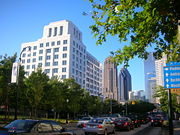
One of seven American cities classified as Gamma world cities, Atlanta ranks third in the number of Fortune 500 companies headquartered within city boundaries, behind New York City and Houston. Several major national and international companies are headquartered in Atlanta or its nearby suburbs, including three Fortune 100 companies: The Coca-Cola Company, Home Depot, and United Parcel Service in adjacent Sandy Springs. The headquarters of AT&T Mobility (formerly Cingular Wireless), the largest mobile phone service provider in the United States, can be found a short distance inside the Perimeter beside Georgia State Route 400. Newell Rubbermaid is one of the most recent companies to relocate to the metro area; in October 2006, it announced plans to move its headquarters to Sandy Springs. Other headquarters for some major companies in Atlanta and around the metro area include Arby's, Chick-Fil-A, Earthlink, Equifax, Georgia-Pacific, Oxford Industries, Southern Company, SunTrust Banks, and Waffle House. Over 75% of the Fortune 1000 companies have a presence in the Atlanta area, and the region hosts offices of about 1,250 multinational corporations.
Delta Air Lines is the city's largest employer and the metro area's third largest. Delta operates the world's largest airline hub at Hartsfield-Jackson Atlanta International Airport and, together with the hub of competing carrier AirTran Airways, has helped make Hartsfield-Jackson the world's busiest airport, both in terms of passenger traffic and aircraft operations. The airport, since its construction in the 1950s, has served as a key engine of Atlanta's economic growth.
Atlanta has a sizable financial sector. SunTrust Banks, the seventh largest bank by asset holdings in the United States, has its home office on Peachtree Street in downtown. The Federal Reserve System has a district headquarters in Atlanta; the Federal Reserve Bank of Atlanta, which oversees much of the deep South, relocated from downtown to midtown in 2001. Wachovia announced plans in August 2006 to place its new credit-card division in Atlanta, and city, state and civic leaders harbour long-term hopes of having the city serve as the home of the secretariat of a future Free Trade Area of the Americas.
The auto manufacturing sector in metropolitan Atlanta has suffered setbacks recently, including the planned closure of the General Motors Doraville Assembly plant in 2008, and the shutdown of Ford Motor Company's Atlanta Assembly plant in Hapeville in 2006. Kia, however, has broken ground on a new assembly plant near West Point, Georgia.
The city is a major cable television programming centre. Ted Turner began the Turner Broadcasting System media empire in Atlanta, where he bought a UHF station that eventually became WTBS. Turner established the headquarters of the Cable News Network at CNN Centre, adjacent today to Centennial Olympic Park. As his company grew, its other channels – the Cartoon Network, Boomerang, TNT, Turner South, CNN International, CNN en Español, CNN Headline News, and CNN Airport Network – centered their operations in Atlanta as well (Turner South has since been sold). The Weather Channel, owned by Landmark Communications, has its offices in the nearby suburb of Marietta.
Cox Enterprises, a privately held company controlled by siblings Barbara Cox Anthony and Anne Cox Chambers, has substantial media holdings in and beyond Atlanta. Its Cox Communications division is the nation's third-largest cable television service provider; the company also publishes over a dozen daily newspapers in the United States, including The Atlanta Journal-Constitution. WSB – the flagship station of Cox Radio – was the first AM radio station in the South.
Atlanta is also home to the Centers for Disease Control and Prevention (CDC). Adjacent to Emory University, with a staff of nearly 15,000 (including 6,000 contractors and 840 Commissioned Corps officers) in 170 occupations, including: engineers, entomologists, epidemiologists, biologists, physicians, veterinarians, behavioral scientists, nurses, medical technologists, economists, health communicators, toxicologists, chemists, computer scientists, and statisticians. Headquartered in DeKalb County, CDC has 10 other offices throughout the United States and Puerto Rico. In addition, CDC staff are located in local health agencies, quarantine/border health offices at ports of entry, and 45 countries around the world. Originally established in 1946 as the Communicable Disease Centre, its primary function was to combat malaria, the deep southeast being the heart of the U.S. malaria zone at the time.
Culture
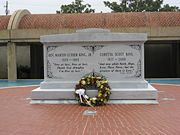
Tourism
Atlanta hosts a variety of museums on subjects ranging from history to fine arts, natural history, and beverages. The Martin Luther King, Jr. National Historic Site honours Atlanta's participation in the civil rights movement. Other history museums and attractions include the Atlanta History Centre; the Atlanta Cyclorama and Civil War Museum (a huge painting and diorama in-the-round, with a rotating central audience platform, that depicts the Battle of Atlanta in the Civil War); the Carter Centre and Presidential Library; historic house museum Rhodes Hall; and the Margaret Mitchell House and Museum.
The arts are represented by several theaters and museums, including the Fox Theatre. The Woodruff Arts Centre is home to the Tony Award winning Alliance Theatre, Atlanta Symphony, and High Museum of Art. The Atlanta Contemporary Art Centre features challenging contemporary art and education geared toward working artists and collectors of art. Museums geared specifically towards children include the Fernbank Science Centre and Imagine It! Atlanta's Children's Museum. The Atlanta Opera, founded in 1979 by members of two struggling local companies, has become one of the fastest growing opera companies in the nation and garners attention from audiences around the world.
Atlanta features the world's largest aquarium, the Georgia Aquarium, which officially opened to the public on November 23, 2005. The new World of Coca-Cola, opened adjacent to the Aquarium in May 2007, features the history of the world famous soft drink brand. Underground Atlanta, a historic shopping and entertainment complex lies under the streets of downtown Atlanta. Atlantic Station, a huge new urban renewal project on the northwestern edge of Midtown Atlanta, officially opened in October 2005. The Varsity in Midtown Atlanta boasts the title of "the world's largest drive-in restaurant".
Piedmont Park hosts many of Atlanta's festivals and cultural events. Atlanta Botanical Garden sits next to the park. Zoo Atlanta, in Grant Park, features a panda exhibit. Just east of the city rises Stone Mountain, the largest piece of exposed granite in the world. Six Flags Over Georgia Theme Park lies a few miles west of Atlanta on I-20.
Entertainment and performing arts
Atlanta's classical music scene includes well-renowned ensembles such as the Atlanta Symphony Orchestra, Atlanta Opera, Atlanta Ballet, period-instrument ensemble New Trinity Baroque, Atlanta Boy Choir, and many others. Classical musicians include renowned conductors such as the late Robert Shaw and the Atlanta Symphony's Robert Spano.
The city has a well-known and active live music scene, though recently rapid gentrification and early venue closing times have hurt small clubs and other music venues. In the early 1980s, Atlanta was the home of a thriving new wave music scene featuring such bands as The Brains and The Producers, closely linked to the new wave scenes in Athens, Georgia and other college towns in the southeast.
Historically there have been a variety of live music traditions going back to Cabbagetown country music pioneer Fiddlin' John Carson, also including a thriving scene in the 90's, also in Cabbagetown, centered around a bar called Dotties, now known as Lenny's and relocated a few blocks away. Video Concert Hall, precursor to MTV, was founded in Atlanta.
Atlanta has been referred to as a Hip-Hop capital due to its giving rise to many now popular rap artists. Areas of the city such as Bankhead, College Park and East Atlanta are often mentioned in songs. Famous Hip-Hop artists that hail from Atlanta include Outkast, Soulja Boy, T.I., Dem Franchise Boyz, Usher Raymond, Young Jeezy, Lil Jon, The Ying Yang Twins, Jermaine Dupri, Yung Joc, Cee-lo Green and Ludacris.
Sports
Atlanta is home to several professional sports franchises, including teams from all four different major league sports in the U.S. The Atlanta Braves of Major League Baseball and the Atlanta Falcons of the National Football League, have played in the city since 1966. The Braves began playing in 1871 as the Boston Red Stockings, and is the oldest continually operating professional baseball team of Major League Baseball. The Braves won the World Series in 1995 and had a recently ended an unprecedented run of 14 straight divisional championships from 1991 to 2005.
The Atlanta Falcons are an American football team of the National Football League have played in Atlanta since 1966. The team currently plays at the Georgia Dome. They have won the division title three times, and one conference championship – going on to lose to the Denver Broncos in Super Bowl XXXIII on January 31, 1999. Atlanta hosted Super Bowl XXVIII in 1994 and Super Bowl XXXIV in 2000.
The Atlanta Hawks of the National Basketball Association have played in Atlanta since 1968. The team's history goes back to 1946, when they were known as the Tri-Cities Blackhawks, playing in the area of Moline and Rock Island, Illinois, and Davenport, Iowa. The team then moved to Milwaukee in 1951, and to St. Louis in 1955, where they won their sole NBA Championship as the St. Louis Hawks. In 1968, they came to Atlanta. In October 2007, the Women's National Basketball Association (WNBA) announced that Atlanta would receive an expansion franchise, beginning league play in May 2008. The new team is the Atlanta Dream, and will play in Philips Arena. The new franchise is not affiliated with the Atlanta Hawks.
From 1972–1980, the Atlanta Flames played ice hockey in the National Hockey League (NHL). The team moved to Calgary, Alberta, Canada in 1980, due to financial difficulties of the owner, and became the Calgary Flames. On June 25, 1997, Atlanta was awarded an NHL expansion franchise, and the Atlanta Thrashers became the city's newest ice hockey team. The Thrashers play at Philips Arena. The team began play on September 18, 1999, losing to the New York Rangers 3-2 in overtime in a preseason game. The Thrashers first home victory came on October 26, 1999, defeating the Calgary Flames.
Atlanta is also home to the Atlanta Silverbacks of the United Soccer Leagues First Division (men) and W-League (women). The city is also being considered for a potential expansion team in Major League Soccer. In golf, the final event of the PGA Tour season, The Tour Championship, is played annually at East Lake Golf Club. This golf course is used because of its connection to the great amateur golfer Bobby Jones, an Atlanta native.
Atlanta has a rich tradition in collegiate athletics. The Georgia Tech Yellow Jackets participate in seventeen intercollegiate sports, including football and basketball. Tech competes in the Atlantic Coast Conference, and is home to Bobby Dodd Stadium, the oldest continuously used on campus site for college football in the southern United States, and oldest currently in Division I-A. The stadium was built in 1913 by students of Georgia Tech. Atlanta also played host to the second intercollegiate football game in the South, played between Auburn University and the University of Georgia in Piedmont Park in 1892; this game is now called the Deep South's Oldest Rivalry. The city hosts college football's annual Chick-fil-A Bowl (Formerly known as The Peach Bowl) and the Peachtree Road Race, the world’s largest 10 km race.
Atlanta was the host city for the Centennial 1996 Summer Olympics. Centennial Olympic Park, built for 1996 Summer Olympics, sits adjacent to CNN Centre and Philips Arena. It is now operated by the Georgia World Congress Centre Authority. Atlanta hosted the NCAA Final Four Men's Basketball Championship most recently in April 2007.
| Club | Sport | League | Venue |
|---|---|---|---|
| Atlanta Falcons | American Football | National Football League | Georgia Dome |
| Atlanta Braves | Baseball | Major League Baseball, NL | Turner Field |
| Atlanta Hawks | Basketball | National Basketball Association | Philips Arena |
| Atlanta Thrashers | Ice Hockey | National Hockey League | Philips Arena |
| Atlanta Dream | Basketball | Women's National Basketball Association | Philips Arena |
| Atlanta Silverbacks | Soccer (Football) | USL First Division | Silverbacks Park |
| Georgia Force | Arena Football | Arena Football League | Arena at Gwinnett Centre |
| Gwinnett Gladiators | Ice Hockey | ECHL | Arena at Gwinnett Centre |
| Atlanta Vision | Basketball | ABA: Blue Conference | The Sampson's Centre |
Law and government
Atlanta is governed by a mayor and a city council. The city council consists of 15 representatives—one from each of the city's twelve districts and three at-large positions. The mayor may veto a bill passed by the council, but the council can override the veto with a two-thirds majority. The mayor of Atlanta is Shirley Franklin.
Every mayor elected since 1973 has been black. Maynard Jackson served two terms and was succeeded by Andrew Young in 1982. Jackson returned for a third term in 1990 and was succeeded by Bill Campbell. In 2001, Shirley Franklin became the first woman to be elected Mayor of Atlanta, and the first African-American woman to serve as mayor of a major southern city. She was re-elected for a second term in 2005, winning 90% of the vote. Atlanta city politics during the Campbell administration suffered from a notorious reputation for corruption, and in 2006 a federal jury convicted former mayor Bill Campbell on three counts of tax evasion in connection with gambling income he received while Mayor during trips he took with city contractors.
As the state capital, Atlanta is the site of most of Georgia's state government. The Georgia State Capitol building, located downtown, houses the offices of the governor, lieutenant governor and secretary of state, as well as the General Assembly. The Governor's Mansion is located on West Paces Ferry Road, in a residential section of Buckhead. Atlanta is also home to Georgia Public Broadcasting headquarters and Peachnet, and is the county seat of Fulton County, with which it shares responsibility for the Atlanta-Fulton Public Library System.
Crime
According to the Federal Bureau of Investigation's annual Uniform Crime Report, Atlanta recorded 90 homicides in 2005, down from 151 in 2004. Violent crime in 2005 was the lowest since 1969. However, Atlanta's incident rate for violent crimes is somewhat higher than for most other major U.S. cities.
Atlanta's Mayor Franklin is a member of the Mayors Against Illegal Guns Coalition, an organization formed in 2006 and co-chaired by New York City mayor Michael Bloomberg and Boston mayor Thomas Menino.
Surrounding cities
The population of the Atlanta region spreads across a metropolitan area of 8,376 square miles (21,694 km²) – a land area larger than that of Massachusetts. Because Georgia contains more counties than any other state east of the Mississippi River (an accident of history explained by the now-defunct county unit system of weighing votes in primary elections), area residents live under a heavily decentralized collection of governments. As of the 2000 census, fewer than one in ten residents of the metropolitan area lived inside Atlanta city proper.
A 2006 survey by the Metro Atlanta Chamber of Commerce counted 140 cities and towns in the 28-county metropolitan statistical area in mid-2005. Four cities – Sandy Springs, Johns Creek, Milton, and Chattahoochee Hill Country – have incorporated or won legislative approval for incorporation since then.
Atlanta's environs include the following suburbs, listed in order of population:
|
|
Education
Colleges and universities
Atlanta has more than 30 institutions of higher education, including the Georgia Institute of Technology, a predominant engineering and research university that has been ranked in the top ten public universities since 1999 by US News and World Report, and Georgia State University. The city also hosts the Atlanta University Centre, a consortium of prestigious, historically black colleges and universities. Its members include Clark Atlanta University, Morehouse College, Spelman College, and the Interdenominational Theological Centre. Adjoining the AUC schools, but independent from them, is the Morehouse School of Medicine. The Savannah College of Art and Design opened a Midtown Atlanta, campus in 2005 and shortly thereafter bought out and closed the Atlanta College of Art. Also in the city are the John Marshall Law School (Atlanta) and the Reformed Theological Seminary.
Suburban Atlanta contains several colleges, including Emory University, an internationally prominent liberal arts and research institution that has continually been ranked as one of the top 20 schools in the United States by US News and World Report; Oglethorpe University, named for the founder of Georgia; Agnes Scott College, an all-women's college; and several state-run institutions such as Clayton State University, Southern Polytechnic State University, Kennesaw State University and Georgia Perimeter College.
Elementary and secondary schools
The public school system ( Atlanta Public Schools) is run by the Atlanta Board of Education with superintendent Dr. Beverly L. Hall. As of 2007, the system has an active enrollment of 49,773 students, attending a total of 106 schools: including 58 elementary schools (three of which operate on a year-round calendar), 16 middle schools, 20 high schools, and 7 charter schools. The school system also supports two alternative schools for middle and/or high school students, two single gender academies, and an adult learning centre. The school system also owns and operates radio station WABE-FM 90.1, a National Public Radio affiliate, and Public Broadcasting System television station WPBA 30.
Transportation
Hartsfield-Jackson Atlanta International Airport ( IATA: ATL, ICAO: KATL), the world's busiest airport as measured by passenger traffic and by aircraft traffic, provides air service between Atlanta and many national and international destinations. Situated 10 miles (16 km) south of downtown, the airport covers most of the land inside a wedge formed by Interstate 75, Interstate 85, and Interstate 285. The MARTA rail system has a station within the airport terminal, and provides direct service to Downtown, Midtown, Buckhead, and Sandy Springs. The major general aviation airports near the city proper are DeKalb-Peachtree Airport ( IATA: PDK, ICAO: KPDK) and Brown Field ( IATA: FTY, ICAO: KFTY). See List of airports in the Atlanta area for a more complete listing.
With a comprehensive network of freeways that radiate out from the city, Atlantans rely on their cars as the dominant mode of transportation in the region – a fact that leads some to call the city "the Los Angeles of the South." Atlanta is mostly encircled by Interstate 285, a beltway locally known as "the Perimeter" which has come to mark the boundary between the interior of the region and its surrounding suburbs.
Three major interstate highways converge in Atlanta; I-20 runs east to west across town, while I-75 runs from northwest to southeast, and I-85 runs from northeast to southwest. The latter two combine to form the Downtown Connector (I-75/85) through the middle of the city. The combined highway carries more than 340,000 vehicles per day. The Connector is of the ten most congested segments of interstate highway in the United States. The intersection of I-85 and I-285 in Doraville – officially called the Tom Moreland Interchange, is known to most residents as Spaghetti Junction. Metropolitan Atlanta is approached by thirteen freeways. In addition to the aforementioned interstates, I-575, Georgia 400, Georgia 141, I-675, Georgia 316, I-985, Stone Mountain Freeway ( US 78), and Langford Parkway (SR 166) all terminate just within or beyond the Perimeter, with the exception of Langford Parkway, limiting the transportation options in the central city.
This strong automotive reliance has resulted in heavy traffic and contributes to Atlanta's air pollution, which has made Atlanta one of the more polluted cities in the country. In recent years, the Atlanta metro area has ranked at or near the top of the longest average commute times in the U.S. The Clean Air Campaign was created in 1996 to help reduce pollution in metro Atlanta.
Notwithstanding heavy automotive usage, Atlanta's commuter rail system, operated by Metropolitan Atlanta Rapid Transit Authority (MARTA), is the seventh busiest in the country. MARTA also operates a bus system within Fulton, DeKalb, and Gwinnett Counties. Clayton, Cobb, and Gwinnett counties each operate separate, autonomous transit authorities, using buses but no trains.
Atlanta has a reputation as being one of the most dangerous cities for pedestrians, as far back as 1949 when the Gone with the Wind author Margaret Mitchell was struck by a speeding car and killed while crossing Peachtree Street.
The proposed Beltline would create a greenway and public transit system in a circle around the city from a series of mostly abandoned rail lines. This rail right-of-way would also accommodate multi-use trails connecting a string of existing and new parks. In addition, there is a proposed streetcar project that would create a streetcar line along Peachtree Street from downtown to the Buckhead area as well as possibly another East-West MARTA line.
Atlanta began as a railroad town and it still serves as a major rail junction, with several freight lines belonging to Norfolk Southern and CSX intersecting below street level in downtown. It is the home of major classification yards for both railroads, Inman Yard on the NS and Tilford Yard on the CSX. Long-distance passenger service is provided by Amtrak's Crescent train, which connects Atlanta with many cities. The Amtrak station is located several miles north of downtown - and it lacks a connection to the MARTA rail system. An ambitious, long-standing proposal would create a Multi-Modal Passenger Terminal downtown, adjacent to Philips Arena and the Five Points MARTA station, which would link, in a single facility, MARTA bus and rail, intercity bus services, proposed commuter rail services to other Georgia cities, and Amtrak.
Greyhound Lines provides intercity bus service between Atlanta and many locations throughout the United States (from coast to coast), Canada, and the Mexican border.
Sister cities
Atlanta has eighteen sister cities, as designated by Sister Cities International, Inc. (SCI):
|
